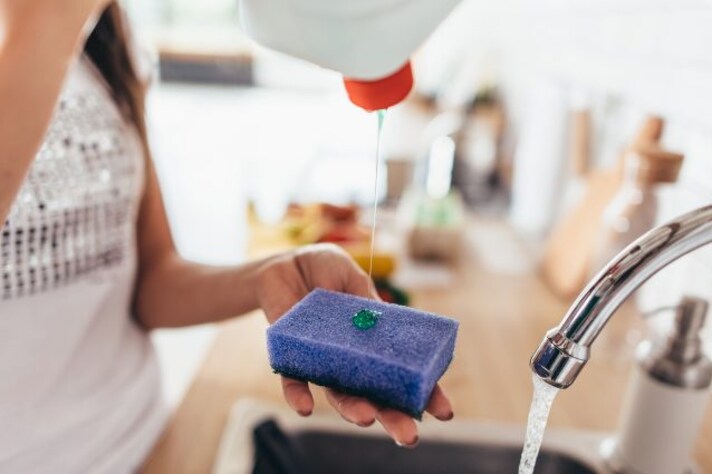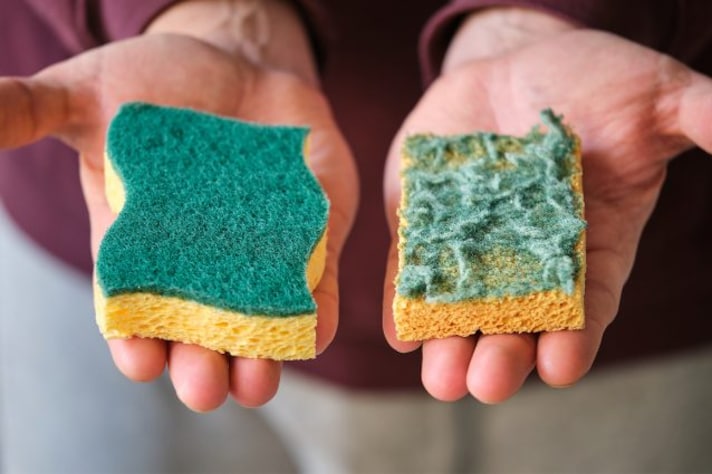How to Clean a Kitchen Sponge Without Bleach: 4 Ways to Keep It Fresh
Despite being a cleaning product, a kitchen sponge needs to be cleaned - regularly, if not everyday - to get rid of all the germs and bacteria harboring inside of it. Read ahead to discover the 4 fastest and easiest ways to do it - without using an ounce of bleach!

When you stock up on cleaning products, it’s easy to assume they’re invincible—always ready to tackle grime without needing any TLC themselves. But take a moment and consider your kitchen sponge. You use it to scrub dishes, wipe down countertops, and handle all sorts of messes. Now, imagine what’s lurking inside that sponge. If you threw it under a microscope, you’d probably be a little horrified by what’s hiding in those squishy fibers. So yes, your kitchen sponge needs to be cleaned—and replaced occasionally.
How Often Should You Clean or Replace a Kitchen Sponge?
Before we get into the cleaning methods, let’s talk frequency. Ideally, you should clean your kitchen sponge daily, or at least every few days, depending on how much you’re using it. A clean sponge will help prevent the spread of bacteria (and keep your kitchen smelling a lot better). As for replacement, sponges generally have a short lifespan—around one to two weeks. If you notice it smells even after cleaning, looks discolored, or starts falling apart, it’s time to say goodbye.

How to Clean a Kitchen Sponge With Vinegar
Vinegar might not smell like flowers, but it’s a natural powerhouse for killing bacteria and germs. To clean your sponge with vinegar, fill a bowl with enough white vinegar to submerge the sponge. Let the sponge soak for about 5 minutes, then squeeze out the vinegar. Rinse it thoroughly with hot water, and voila! The acidity in vinegar works to kill off bacteria, making your sponge feel fresh and ready for action again. Plus, you’re doing it without any harsh chemicals. Win-win!
How to Clean a Sponge With Boiling Water
Boiling water is another tried-and-true method for cleaning your sponge. Bring a pot of water to a rolling boil and toss the sponge in for about 5 minutes. The boiling temperature kills most bacteria and germs lurking in the sponge fibers. Just make sure to let the sponge cool off before using it again—nobody wants a burnt hand while scrubbing dishes! This method is great because it’s simple and effective, with nothing more than good old H2O doing the work.

How to Clean a Kitchen Sponge With the Microwave
Cleaning your sponge in the microwave might sound strange, but it’s one of the fastest ways to disinfect it. Wet the sponge first (this is important—don’t put a dry sponge in the microwave!) and microwave it on high for about 1-2 minutes. The heat will kill most bacteria living in the sponge. After microwaving, let the sponge sit for a minute or two before taking it out because it will be extremely hot. This method is quick, convenient, and surprisingly effective at keeping your sponge fresh.
How to Clean Your Kitchen Sponge in The Dishwasher
Got a dishwasher? Your sponge can hitch a ride. Simply place the sponge on the top rack of your dishwasher and run it through a normal cycle. The combination of hot water and detergent will give your sponge a deep clean while your dishes get scrubbed, too. It’s multitasking at its finest! Just make sure the cycle includes a heated dry to get rid of any lingering moisture that could cause bacteria to grow again.
;Resize,width=767;)



